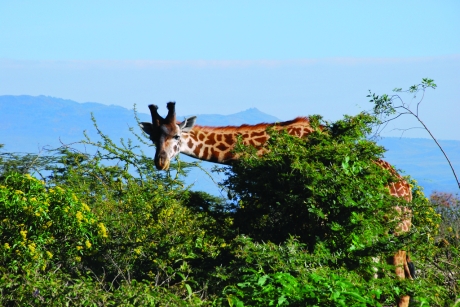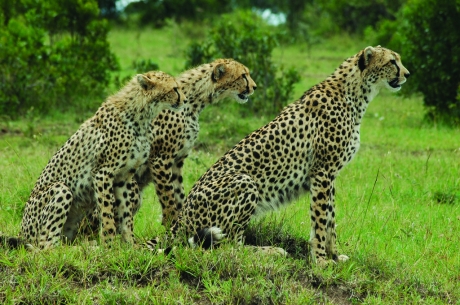Giraffe, Crescent Island, Lake Naivasha, Kenya (Fred Tooley)
Good nature photography takes years of painstaking study and practice, first-rate equipment and a great deal of patience. But as Houston architect Fred Tooley discovered, spectacular shots are there for the taking on safari, and you don’t have to be a professional photographer to get them.
I asked him to share his top ten photo tips, and he was generous – he even gave us an extra. For a more extensive collection of his photos, and other Houston safari travelers, see African Adventures, and keep an eye out for their story in Buzz Magazines.
Cheetah Family, Masai Mara National Park, Kenya (Fred Tooley)
1. If this is the trip of a lifetime (like it was for us) it is not the time to get by with a point-and-shoot camera. Use a good quality SLR with interchangeable lenses, You can rent them online or from a camera shop if you do not want to buy. You wouldn’t take a cheap gun on an African hunt, so why take a cheap camera for this other kind of shooting?
2. Today the zoom lens rules, and this is perfect for an Africa trip. The animals are not going to wait for you to change to the right focal length lens.Probably 75% of my photos were taken with an 18-200 mm vibration reduction zoom. The remainder were taken with a second camera (highly recommended) using a 70-300 mm zoom.
3. I bought a used backup camera and lens (the 70-300) in case my “go-to” camera malfunctioned. But they both functioned perfectly througout the trip, and having a second camera is a real plus. Sharon decided to become a photographer on the trip, and today’s modern digitals make it easy to learn the basics on the fly. When one of us was not in good position for a photo, then the other usually was.
4. Leave the tripod and monopod at home. You can’t use them in the vehicle, and if you get out, you get eaten. A window-clamp type mount was very handy however.
5. If I made a mistake it was taking the 500mm lens for those long shots. The window-mount is not stable enough for such a lens, it is cumbersome, and it weighs about 1800 lbs. (I think).
6. Before you leave, test your lens and be sure it is sharp, sharp, SHARP. Every lens you purchase will be advertised as sharp, but many are not. Try zooming in on a small sign a couple of blocks away, and then blow it up on the computer. A sharp lens can make a huge difference, unless you are only going to send low-res shots to friends on the Internet. Thishttp://www.kenrockwell.com/ is an excellent site for an expert opinion on various lenses.
7. Take a dust-proof camera bag that you can access quickly. The 4×4 is not going to be air-conditioned, and the dust kicked up by another vehicle can be daunting. The “dry season” would have been much much worse.
8. Sit in the front passenger seat if you are the chief photographer. A good driver will always position the vehicle for you to get a good shot, and you don’t have to stand up (dropping your lens cap off your lap) to shoot through the open roof. This is more important than you might imagine.
9. Take many many many) photos. It costs you nothing, and you never know when the animal may make a subtle change in position or expression that you did not even notice. Once in a while you will accidently catch a bird in flight in the background, or a butterfly flies into your frame and you did not even notice till you got home.
10. Most important: As tempting as it may be, don’t make the mistake of seeing your entire trip through a camera lens only. Experience it fully.
11. One of the smartest things I did was to purchase (online) a small reasonably priced “inverter”. This is a small “black box” that converts 12 volts (from the vehicle’s lighter plug-in) to 120 volts (for battery charging or whatever) with a standard American 3-prong outlet. The vehicle was set up with a convenience outlet, but since Africa uses 220 volts, these outlets could not be used without a converter and plug adaptor. Since we were in the vehicles most of each day, charging the spare batteries was a snap with the inverter. And imagine the gratitude of our guide when I left it with him as a gift for use by his American clients.


Leave a Reply